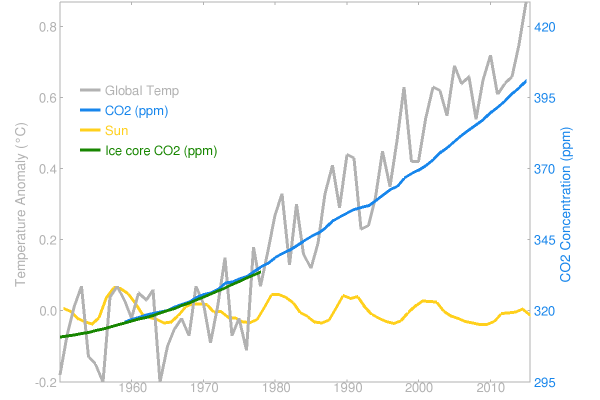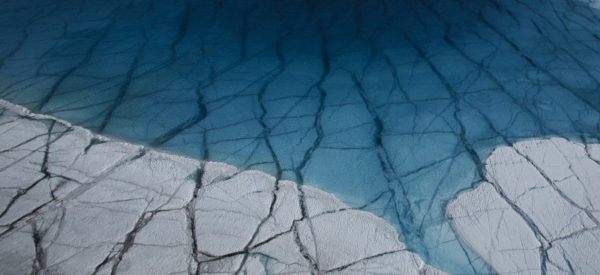The recent US election has prompted cries that the decision on Earth’s climate has now been irrevocably made, that the US has unilaterally decided to scrap the peak warming target from the Paris agreement of 1.5 oC. What do the numbers say? Is Earth’s climate now irrevocably fracked?
Archives for November 2016
Record heat despite a cold sun
Global temperature goes from heat record to heat record, yet the sun is at its dimmest for half a century.
For a while, 2010 was the hottest year on record globally. But then it got overtopped by 2014. And 2014 was beaten again by 2015. And now 2016 is so warm that it is certain to be once again a record year. Three record years in a row – that is unprecedented even in all those decades of global warming.
Strangely, one aspect of this gets barely mentioned: all those heat records occur despite a cold sun (Figs. 1 and 2). The last solar minimum (2008-2010) was the lowest since at least 1950, while the last solar maximum (2013-2015) can hardly be described as such. This is shown, among others, by the sunspot data (Fig. 1) as well as measurements of the solar luminosity from satellites (Fig. 2). Other indicators of solar activity indicate cooling as well (Lockwood and Fröhlich, Proc. Royal Society 2007).
Fig. 1 Time evolution of global temperature, CO2 concentration and solar activity. Temperature and CO2 are scaled relative to each other according to the physically expected CO2 effect on climate (i.e. the best estimate of transient climate sensitivity). The amplitude of the solar curve is scaled to correspond to the observed correlation of solar and temperature data. (Details are explained here.) You can generate and adapt this graph to your taste here, where you can also copy a code with which the graph can be embedded as a widget on your own website (as on my home page). Thus it will be automatically updated each year with the latest data. Thanks to our reader Bernd Herd who programmed this. [Read more…] about Record heat despite a cold sun
Unforced variations: Nov 2016
Don’t make a choice that your children will regret
Dear US voters,
the world is holding its breath. The stakes are high in the upcoming US elections. At stake is a million times more than which email server one candidate used, or how another treated women. The future of humanity will be profoundly affected by your choice, for many generations to come.
The coming four years is the last term during which a US government still has the chance, jointly with the rest of the world, to do what is needed to stop global warming well below 2°C and closer to 1.5°C, as was unanimously decided by 195 nations in the Paris Agreement last December. The total amount of carbon dioxide the world can still emit in order to have at least a 50% chance to stop warming at 1.5 °C will, at the current rate of emissions, be all used up in under ten years! This time can only be stretched out by making emissions fall rapidly.
Even 2°C of global warming is very likely to spell the end of most coral reefs on Earth. 2°C would mean a largely ice-free Arctic ocean in summer, right up to the North Pole. Even 2°C of warming is likely to destabilize continental ice sheets and commit the world to many meters of sea-level rise, lasting for millennia. Further global warming will likely lead to increasing extreme weather, droughts, harvest failures, and the risk of armed conflict and mass migration.
Meltwater on the Greenland Ice Sheet. Photo with kind permission by Ragnar Axelsson.
In case you have any doubts about the science: in the scientific community there is a long-standing consensus that humans are causing dangerous global warming, reflected in the clear statements of many scientific academies and societies from around the world. None of the 195 governments that signed the Paris Agreement saw any reasons for doubting the underlying scientific facts; doubts about the science that you see in some media are largely manufactured by interest groups trying to fool you.
You have a fateful choice to make. The policies of candidates and parties on climate change could hardly be more different. Hillary Clinton would continue to work with the international community to tackle the global warming crisis and help the transition to modern clean and renewable energies. Donald Trump denies that the problem even exists and has promised to go back to coal and to undo the Paris Agreement, which comes into force today, the 4th of November 2016, as culmination of over twenty years of negotiations.
Please consider this carefully. This is not an election about personalities, it is about policies that will determine our future for a long time to come. While the presidential race has gotten the most attention, voters should consider climate not just at the ‘top of the ticket’, but all the way down the ballot. Don’t make a choice that you, your children and your children’s children will regret forever.
David Archer, Rasmus Benestad, Ray Bradley, Michael Mann, Ray Pierrehumbert, Stefan Rahmstorf and Eric Steig
Carbon storage in WA state forests is too small and too risky to play a serious role as a climate change mitigation tool
Guest post by John Crusius, Richard Gammon, and Steve Emerson
The scientific community is almost universally in agreement that climate change (and ocean acidification) are severe threats that demand a rapid response, with putting a price on fossil fuel CO2 emissions being a top priority. Far and away the single biggest contributor to climate change is CO2 emissions from fossil fuel combustion. Indeed, global CO2 emissions from fossil fuel emissions in recent years have been roughly ten times higher than emissions from the next largest global source, land use change, including deforestation (Le Quéré et al., 2015). Despite the small size of carbon fluxes from forests, enhancing carbon storage in forests is often discussed in WA state as a tool to fight climate change. There was one such claim in the Seattle Times OpEd from October 21 by Mathew Randazzo. We challenge these claims that forest carbon sequestration in WA state can significantly help solve climate change. Randazzo does not spell out in any detail what he means. As always, details matter in such discussions, as the science is complex. We focus here on some of the best available science on the climate and carbon storage impacts of forests, and provide references at the bottom of this article from some of the premier scientific journals in the world.

